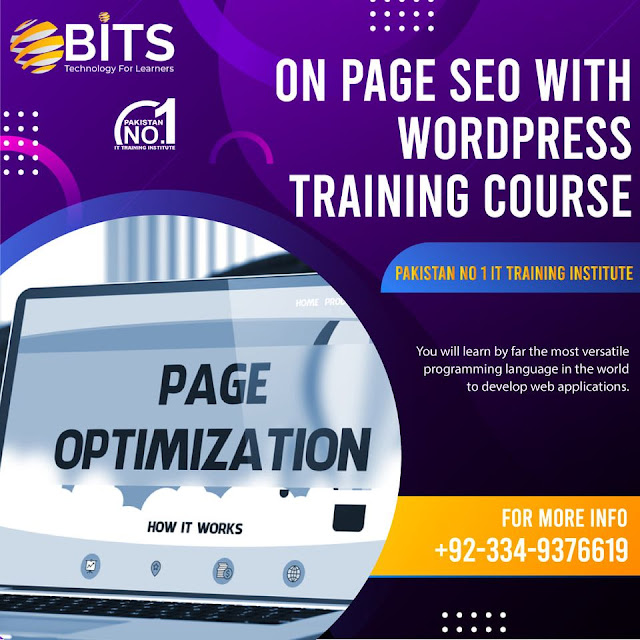On-page optimization is a part of SEO optimization. It consists of technical, structural, and content adjustments that are made on a website. On-page optimization can also be called in-site optimization and complements the so-called off-page optimization. Both variants build overall SEO optimization and thus are elementary for the success of a website. The goal of on-page optimization is to sustainably improve search engine rankings by improving the technique, structure, and content of a website. The visibility of a website is also improved as well as the usability of a page.
 |
| On-Page optimization |
Composition of on-page optimization
On-page optimization consists of different elements which can be subdivided. Basically, the goal is to build a technically perfect website that loads quickly, with unique content that stands out from all other websites for a specific search term or topic. The content must optimally satisfy the user's search needs, while the technology and performance ensure that this content is optimized and indexed by the Googlebot and search engines, as well as being read by the user with any device at any time
Combination of on-page and off-page optimizations
On-page optimization should always be combined with off-page optimization, because building backlinks without a strong, optimized landing page is unproductive. It also requires constant monitoring of the website, in order to maintain and permanently control all on-page and off-page factors of a website.
Keyword positioning
The closer a keyword is to the domain name, the better the ranking of the subpages will be in relation to this keyword. This rule has long been circulated in SEO circles. However, the presence and position of the keywords in the URL are no longer relevant for SEO. For users and search engines, however, keywords are still important for orientation on the page. In the context of the focus keyword, it makes sense to place a keyword in the URL.
Click depth / directory depth
Click depth describes the path, which indicates how often you must click on a web page to access the content you want from the home page. Any link that does not point to the home page of a website is called a deep link. The more you have to navigate the page, the greater the click depth. The recommendation from an SEO optimization point of view is: the lower a click depth to different subpages, i.e. a short click path, the more understandable the website will be for them. users and search engines.
HTML Head
Title tag
The title tag, also known as the meta title, is the most important meta element within a website, as it is almost always used as a title in the SERPs. At the same time, the title is important for ranking. This is why the title should always consist of the central keyword of the landing page or contain the most important descriptive words.
Meta description tag
The meta description does not affect search engine rankings. However, it can be used to increase website traffic from the SERPs. The description appears in search results as a snippet. The snippet provides a short description of the page, in order to give a first look at the content of the site. It is important here that the keywords in the description are displayed in bold. It is highly recommended to include keywords in the text, in order to grab the user's interest and attention and to liven it up with a call to action.
Header tag
Headers (h1 through h6 in HTML code) allow browsers, search engines, and screen readers to recognize titles. Search engines and users can better capture and categorize content using header tags. It is generally recommended that you only use one H1 tag per URL and include the main keyword of the page in it.
The ALT attribute
The ALT property is used to insert text into media (images or videos). It is necessary because search engines cannot process such files. Alt-text is also required for a reduced number of visitors to a site so that a screen reader can see the meaning of the medium. The ALT property has proven to be particularly related to top rankings. It is therefore recommended to include an image or other media in the important pages and to mention the keyword within the ALT property. Again, this should not be done in an exaggerated way, otherwise, the search engines could detect excessive or inconsistent use of keywords in the ALT property,
Name the image files
Website traffic can also be generated by image searches. This is why an image file must be named meaningfully and contain the correct keyword. which would subsequently be penalized (see keyword stuffing).
Bold / Italic
Keywords that are formatted in the bold or italicized text can slightly influence a website's ranking. Webmasters should appropriately enrich their texts, especially by playing on keywords or combinations of terms, because users could benefit from it.
Exploration and indexing
robots.txt
To ensure that all relevant areas can be crawled by the Googlebot, the entire website must be reachable. The robots.txt file provides this aspect. It provides crawlers with instructions to follow as they navigate to the page.
sitemap.xml
Using a Sitemap.xml, all URLs for a website are presented in a search engine readable form and saved in Google Search Console. This allows all URLs on a website to be transmitted to Google. Thus, the possibility of these items being crawled and indexed increases.
Technical
Speed page
The loading speed of a website increases its ease of use. On the other hand, this is a positive ranking sign for Google. As part of on-page optimization, it is recommended to keep file sizes and server requests as low as possible.
Mobile optimization
Mobile accessibility is a ranking factor for Google. For this reason, on-page optimization is also about improving a website for mobile devices, such as smartphones or tablets.
